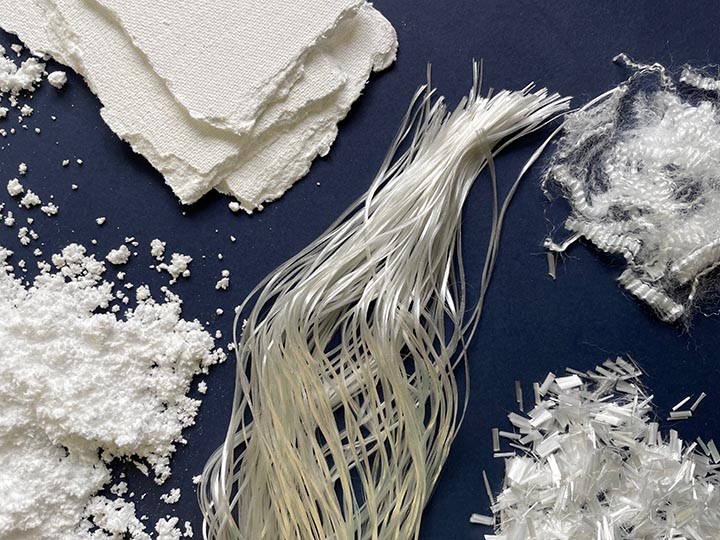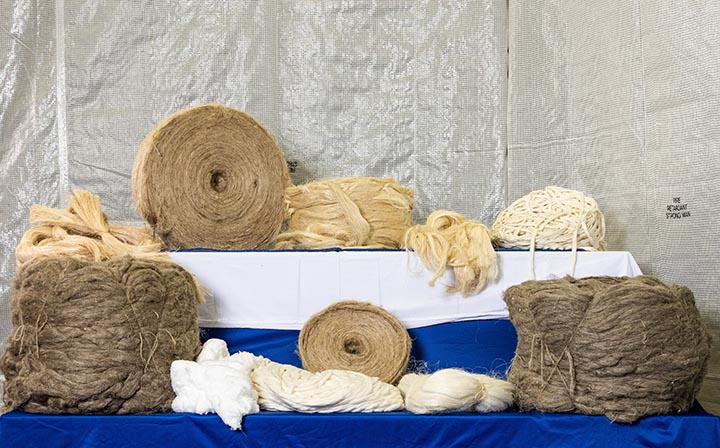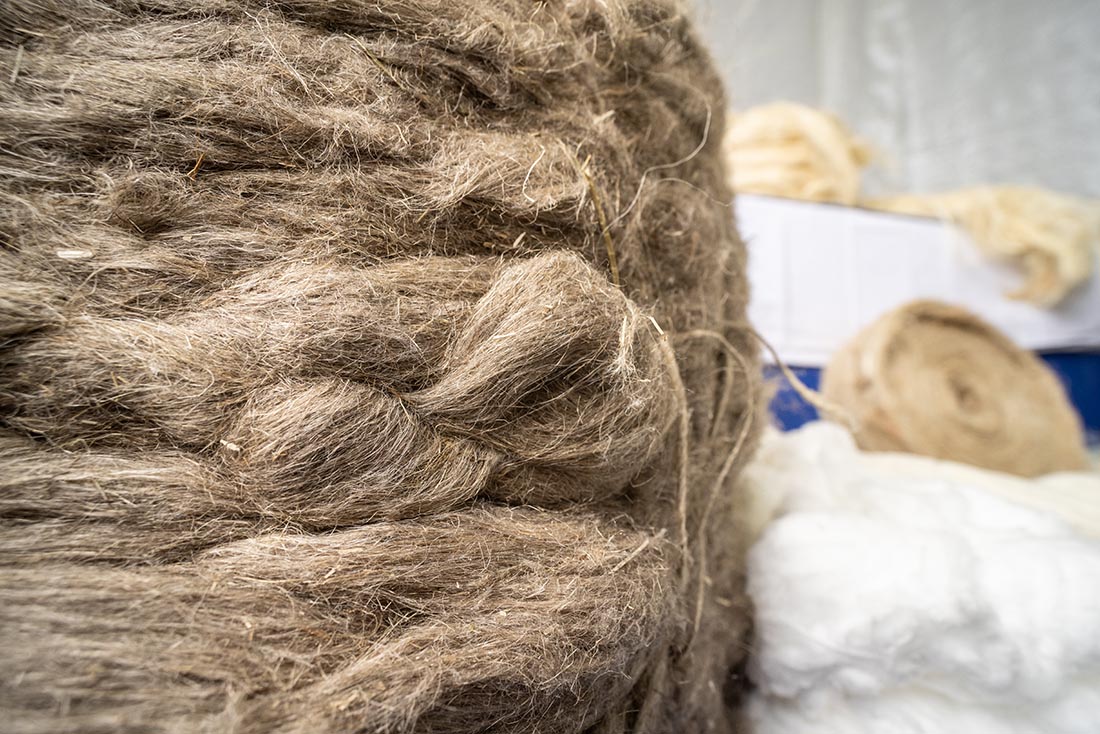A Pathway to Sustainable Textiles
The global textile industry involves the production, processing, and distribution of various fibers, fabrics, and finished textile products. It encompasses a wide range of activities, including fiber cultivation, spinning, weaving, knitting, dyeing, printing, and garment manufacturing. Unfortunately, the textile industry has been associated with several environmental challenges and impacts throughout its value chain.
The industry is increasingly recognizing the need for sustainable practices and materials to mitigate its environmental impact. Sustainable textiles encompass various approaches, including the use of bio-based fibers, recycled fibers, eco-friendly dyeing processes, and circular economy principles. Bio-based fibers and yarns are promising solutions by utilizing renewable resources and reducing reliance on fossil fuels.
Bio-based fibers and yarns are materials that are derived from renewable plants, animals, or mineral sources, as opposed to fibers that come from petroleum-based sources. These materials are becoming increasingly popular in the textile industry because they are more sustainable and eco-friendlier than man-made materials. What was old is now new again. Bio-based fibers can be spun into yarns that can then be used to make a wide range of textile products, such as clothing, bedding, and towels.
Plant-based biomass sources include cotton, flax, hemp, bamboo, jute, and sisal. These fibers are obtained from the stems, leaves, or seeds of plants. Plant-based fibers are widely used in the textile industry and are known for their comfort, breathability, and versatility. Animal-based fibers are obtained primarily through shearing, combing, or collecting naturally shed fibers. Examples include wool from sheep, cashmere from goats, silk from silkworms, and angora from rabbits. Animal-based fibers are valued for their insulation properties, softness, and luxurious feel. Microorganisms, such as bacteria and fungi, can be engineered to produce bio-based fibers through fermentation processes. Microbial fermentation offers the potential to create novel and sustainable fibers with customizable properties.
The extraction and processing methods for bio-based fibers depend on the biomass source and the desired characteristics of the fibers. Some common methods include:
Mechanically separating fibers from the plant or animal matrix through processes such as retting, decortication, ginning, or carding. These methods mechanically remove non-fiber components and align the fibers for further processing. Chemical methods use solvents or chemical treatments to dissolve or break down non-fiber components, allowing the extraction of pure fibers. Examples include the use of alkali solutions for processing plant-based fibers like bamboo or wood pulp for cellulose fibers. Enzymatic processes utilize enzymes to break down non-fiber components selectively. Enzymes can be used to treat plant-based fibers like hemp or bamboo, facilitating the separation of fibers from other plant constituents. Advances in biotechnology have enabled the development of genetically modified microorganisms capable of producing specific fibers. Through fermentation processes, these microorganisms can synthesize fibers directly, bypassing the need for extraction from biomass sources.

Fiber formation techniques play a crucial role in determining the final properties and characteristics of the bio-based fibers, such as strength, diameter, length, and surface texture. Once the fibers are extracted or synthesized, they undergo fiber formation techniques to transform them into usable forms for textile applications.
While biobased fibers offer numerous benefits, there are also challenges and limitations that need to be addressed.
Spinning is the most common technique for forming fibers. It involves drawing out the extracted fibers into continuous filaments and twisting them to enhance strength and cohesion. Spinning methods can vary depending on the fiber type, including ring spinning, open-end spinning, and air jet spinning. Extrusion is a technique used for synthetic bio-based fibers. It involves melting or dissolving the biopolymer and extruding it through spinnerets to form continuous filaments. The extruded filaments are then solidified, often through cooling or chemical processes, to create the fibers. Wet spinning is a process used to produce regenerated cellulose fibers, such as viscose and lyocell. It involves dissolving the cellulose in a solvent and extruding it into a coagulation bath, where the solvent is removed, and the cellulose solidifies into fibers.
The adoption of bio-based fibers and yarns in textile production brings multiple environmental benefits, including the conservation of resources, reduction in greenhouse gas emissions, and the potential for a more circular and sustainable textile economy. Biomass sources for bio-based fibers often sequester carbon dioxide during growth, helping to offset emissions and mitigate climate change impacts. By embracing these fibers, the industry can move towards a more sustainable and responsible approach to meet the growing demand for textiles.
While bio-based fibers offer numerous benefits, there are also challenges and limitations that need to be addressed. Some key considerations include supply chain and related scalability issues, technical limitations and durability and performance concerns.
The production of bio-based fibers relies on a complex supply chain involving sourcing, cultivation, extraction, and processing of biomass sources. Scaling up the production of bio-based fibers to meet the demand of the textile industry can be challenging. Issues such as inconsistent quality, limited availability of biomass sources, and the need for infrastructure development pose hurdles to achieving large-scale production, widespread adoption of bio-based fibers.

The production processes for bio-based fibers often require specialized technologies and equipment, which may be limited in availability or require further development. Technological advancements are necessary to improve the efficiency, quality, and cost-effectiveness of bio-based fiber production. Additionally, the cost of bio-based fibers can be higher compared to conventional fibers due to factors such as limited economies of scale, processing complexities, and availability of raw materials. Addressing these limitations is crucial to make bio-based fibers more accessible and competitive in the market.
Bio-based fibers may face challenges related to durability, strength, and performance compared to conventional synthetic fibers. Achieving the desired performance characteristics, such as tensile strength, abrasion resistance, and colorfastness, while maintaining the sustainable attributes of bio-based fibers requires ongoing research and development. Improvements in fiber processing techniques, fiber modifications, and blending with other fibers can help enhance the performance and durability of bio-based fibers.
Overcoming these challenges and limitations requires investments in research and development, technological innovation, sustainable sourcing practices, and infrastructure development are essential to drive the growth and adoption of bio-based fibers in the textile industry. By addressing these challenges, the industry can unlock the full potential of bio-based fibers and contribute to a more sustainable and responsible future.
Bio-based fibers have significant market opportunities and economic potential, driven by the growing demand for sustainable textiles, evolving consumer preferences, and the potential for new business models. As sustainability becomes a central focus in the textile industry, bio-based fibers have the potential to capture a larger market share and meet the demand for sustainable textiles. The market for bio-based fibers is driven by trends such as “green” and “clean” fashion, circular economy principles, and a desire for transparency in supply chains. The adoption of bio-based fibers can stimulate the development of new business models and value chains in the textile industry. From sourcing biomass materials to fiber production, processing, and distribution, bio-based fibers offer opportunities for innovation and collaboration across the value chain.
In order maximize the benefits of bio-based fibers, advancements in fiber extraction and processing technologies, improvement in fiber properties and performance, expansion of biomass feedstock options, and collaboration between academia, industry, and policymakers are key areas for focus. Additionally, research should prioritize life cycle assessments (LCAs) and sustainability certifications to provide transparent information about the environmental impacts and benefits of bio-based fibers. These assessments can inform decision-making processes, guide the development of best practices, and enable the adoption of standardized sustainability metrics.
The adoption and utilization of bio-based fibers and yarns presents a pathway towards a more sustainable and responsible textile industry. By addressing the challenges, driving research and development, and providing policy support, the industry can accelerate the transition towards a more environmentally conscious and economically viable future in the textile sector. At MiniFIBERS we continue to work with our partners to bring responsibly sourced and sensible natural, bio-based, recycled, upcycled and second life fibers to the market. We continue to innovate our processes to provide what our customers need to be competitive and meet their circularity goals.


